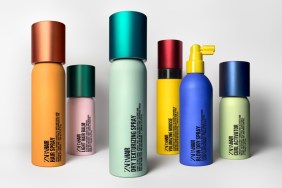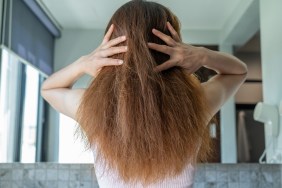Textured hair, whether wavy, curly, coily, crinkled or crimped, can be a nightmare to deal with when matted or tangled. For most, untangling the mess is a dreaded chore. And if attacked incorrectly, the process can lead to hair breakage and damage.
To help us tackle the loathsome task, we asked Kerry Washington’s hairstylist, Takisha Sturdivant-Drew, about the proper method for untangling textured hair, whether natural or chemically straightened. Here are 11 tips and techniques to help you detangle hair without damaging it.
Leave-Ins Are Your Friends
Textured hair is often dry and parched. Before you begin detangling it, coat it with a leave-in moisturizing cream, oil or spray. This leave-in conditioner will soften your hair, making it more manageable, thereby facilitating the comb-through process. Experiment with different types to find the one that works best with your hair texture and type. If your hair texture is extra frizzy or dry, take special care by concentrating the moisturizing efforts on the ends of you hair. Seal the moisture in with hair butter or light oil.
Take Your Time
Allow yourself enough time to properly detangle your naturally textured or relaxed hair. Rushing through the process and using rough manipulation while handling tangled or knotted hair causes rips, snags and split ends. To reduce hair damage and reach longer lengths, textured tresses need to be handled with care.
Section It Off
Before you begin the detangling process, you should section your hair into four manageable parts (two in the front, two in the back) to make the process easier. If your hair is very thick, eight sections (four in the front, four in the back) would be better for you. Freeform detangling of textured hair will only lead to unnecessary breakage.
Use Your Hands
Your fingers are your best secret weapon in your fight against tangles. Use them to work apart sections of hair that have attempted to mat or clump together. Then run your fingers slowly through your strands, working in sections from the ends up to detangle. Make sure your fingernails are smooth and not ragged, so they don’t snag or tear your hair.
Choose the Right Hair Tool
Wide-tooth combs with long teeth are great for unsnarling all types of textured tresses with little damage. Look for a seamless one, so your hair doesn’t snag on the seams and damage its cuticle. “A wide-tooth bone comb is the best one to use,” says Sturdivant-Drew. “It leads to less tension on the hair and will not pull or break the strands.” Seamless wood, resin and horn combs work well, too.
For curly-haired gals, if you must use a brush, she advises using a good quality vent brush with natural hair fibers (boar bristles are a good option). “Part the hair in sections, then start at the nape of the neck by slowly and carefully brushing the hair and working your way up to the crown,” says Sturdivant-Drew. Brushing relaxed hair when wet is not advised.
Always Work Your Way Up
Never, ever start the detangling process at the roots of your hair. Always start at the ends and work your way up slowly to minimize breakage. When utilizing a wide-tooth comb, “you should be holding on to the roots to prevent tension and breakage,” adds Sturdivant-Drew. If a snarl is encountered, gently work your way through until the knot is removed.
Clip It
Once a section of hair has been fully untangled, twist and clip it out of the way so it doesn’t interfere with the other sections of hair that you have to work through. Tip: If clips aren’t available, you can simply braid the sections.
Keep Hair Well Conditioned
The easiest way to manage your hair is if it has fewer tangles to begin with. The less rough and dry the texture, the less likely it is to get tangled. Hence, after cleansing with a non-sudsing, sulfate-free shampoo (using only downward strokes to avoid hair tangling), rinse hair with warm water, then use a generous amount of moisturizing conditioner. Work the conditioner through using your fingers (again downward strokes only) or a seamless, wide-tooth comb. Leave in for 10 to 15 minutes, then wash it out with cool water.
Your Hair Needs a Detox, Too
According to Sturdivant-Drew, “A lot of times the hair is tangled because of all of the built-up products.” She recommends using a clarifying shampoo every few weeks to remove the product buildup and to make hair more manageable.
Dry It Right
Rubbing or scrunching your hair with a cotton towel to dry it often causes unnecessary tangles; thus, it should be avoided whenever possible. Instead, use your hands to softly squeeze excess water out of your hair. Afterward, dab your hair gently with a microfiber towel or T-shirt to create less friction with the hair shaft and to absorb additional water. And if air-drying or blowdrying, don’t forget to apply a moisturizing leave-in conditioner to keep your hair soft and supple. “But don’t overdo it,” says Sturdivant-Drew. “It can weigh down the hair. If using a moisturizing spray, spritz hair 3 to 4 inches away.” For drier hair textures, seal with a light oil or body butter if necessary.
Sleep on It
At night, we often toss and turn, leading to snarls and knots that make the comb-out process in the morning nearly impossible. To reduce hair friction and matting, it’s best to use a protective style and tie it up with a silk scarf at night. If your hair is straightened, Sturdivant-Drew suggests that before you go to bed, you “comb or brush the hair all the way through to make sure you don’t have any knots in it. Then wrap your hair around your head, keeping it in place with pins. Alternatively, you can also pull all of the hair up in one pin to keep the style.”
For curly hair, she suggests twisting the hair in large sections to keep the texture, then pinning it in place or taking the large sections and braiding them instead. Similarly, you can also try the pineappling method to keep your curls bouncy and springy. Finally, don’t forget to switch out your cotton pillowcase for a satin one. Cotton absorbs the essential oils in your hair causing it to be drier and frizzier. Satin cases, on the other hand, cause less friction and allow natural oils and any additional evening moisturizing treatments to condition your hair without worry of excessive fabric absorption.
Ultimately, if you condition and moisturize your hair properly, allot the proper time and care and protect your hair from additional stress, untangling your hair will be a breeze.







